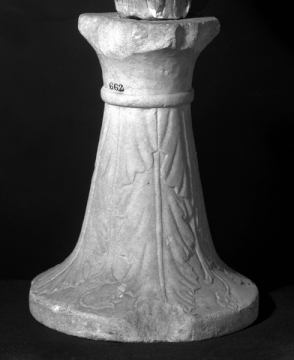Explore Collections


You are here:
CollectionsOnline
/
Base of a Roman fountain
Browse
Base of a Roman fountain
Roman Imperial period
Italian marble
Height: 36cm
Circumference (top): 49cm
Circumference (bottom): 81cm
Circumference (top): 49cm
Circumference (bottom): 81cm
Museum number: M662
On display: Sepulchral Chamber
All spaces are in No. 13 Lincoln's Inn Fields unless identified as in No. 12, Soane's first house.
For tours https://www.soane.org/your-visit
Curatorial note
A turned pedestal and base with three relief fillet bands and inverted acanthus leaf enrichment in flat relief between/within the lower two. The type does not differ from the similar supports to large Piranesi-type marble bowls, but the wide circular channel from top to bottom indicates that this example at least was the support of a "bird bath" type fountain - a shallow bowl from which a fountain spout emerged at the centre.
This is a piece of garden sculpture of the Roman Imperial period. A similar base or pedestal ensemble with the same inverted foliate enrichment is also used to support the marble font for lustral water, from the Temple of Isis at Pompeii and preserved in the Museo Nazionale, Naples1.
This form of fountain-base is an enriched version of a support popular throughout the Greek imperial world and introduced to Italy in the time of Cicero and later. In the fourth through sixth centuries AD, the new Christian era, this shape became standard for baptismal fonts and altar-tables. Examples are to be found scattered about most Late Antique sites in the Aegean and Eastern Mediterranean worlds2.
1 P. Gusman, Pompei: The City, its Life and Art, trans. F. Simmonds and M. Jourdain, London, 1900, p. 81.
2 For other related fountains, complete or partly-restored, see G. Lippold, (Vatikan Katalog) Die Skupturen des Vaticanischen Museums, Berlin, 1956, III, 2, pl. 22, Galleria dei Candelabri, no. 106.
This is a piece of garden sculpture of the Roman Imperial period. A similar base or pedestal ensemble with the same inverted foliate enrichment is also used to support the marble font for lustral water, from the Temple of Isis at Pompeii and preserved in the Museo Nazionale, Naples1.
This form of fountain-base is an enriched version of a support popular throughout the Greek imperial world and introduced to Italy in the time of Cicero and later. In the fourth through sixth centuries AD, the new Christian era, this shape became standard for baptismal fonts and altar-tables. Examples are to be found scattered about most Late Antique sites in the Aegean and Eastern Mediterranean worlds2.
1 P. Gusman, Pompei: The City, its Life and Art, trans. F. Simmonds and M. Jourdain, London, 1900, p. 81.
2 For other related fountains, complete or partly-restored, see G. Lippold, (Vatikan Katalog) Die Skupturen des Vaticanischen Museums, Berlin, 1956, III, 2, pl. 22, Galleria dei Candelabri, no. 106.
Rome; collected in Rome by Charles Heathcote Tatham for the architect Henry Holland during the 1790s. See Cornelius Vermeule, unpublished catalogue of the Antiquities at Sir John Soane's Museum, Introduction, transcription of Tatham letters, Tatham, Letters, List 3, no. 9.
Literature
Tatham: Drawings, 8.
Soane collections online is being continually updated. If you wish to find out more or if you have any further information about this object please contact us: worksofart@soane.org.uk


